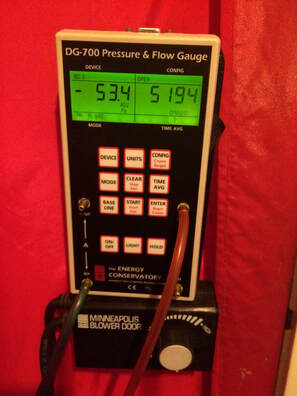|
This position typically takes people by surprise. To be clear, I'm talking about single family homes in particular. Let's explore the details. First off, definitions. A heat pump moves heat from one place to another. Your refrigerator is a heat pump. It takes heat out of the cold air inside and pushes it into your kitchen. The source is the cold air inside your fridge, the place it rejects the heat is into your house. An air conditioner is technically a heat pump, it takes heat from inside your house and ejects it into the hot outdoors through something called the refrigeration cycle, but let's just call it magic, it's easier. An "air source heat pump" in US parlance is an air conditioner that can heat as well as cool. I jokingly think of it like a bisexual AC, it goes both ways. Sometimes silly jokes like that stick. In winter it takes heat out of the cold outdoor air and puts it inside your house. Again, think of it as magic, but it's EXACTLY what your fridge does. A ground source (aka geothermal) heat pump takes heat from the earth through a long pipe loop that is either horizontally about 6 feet down in a large field like a septic field, or vertically several hundred feet down that takes up very little space in your yard. The Question Joel Zook in the Electrify Everything Facebook Group asked me my position on ground source for his older home in a very cold climate (Climate Zone 6, Wisconsin and Minnesota are the only states with substantial population in those zones.) My Answer That would be a place to consider them. My issue is that even after the tax credit they are typically $10-20K more. That $10-20K can usually make a good sized dent in shell work. This client spent ~$35k on a ground source heat pump, which is about $25K after the tax credit. He had very high energy bills and an uncomfortable house. He could have forgone the tax credit, spent $5,000 more out of pocket, got an air source heat pump and an insulation and air sealing package, then had very low bills and a comfortable house. Instead, he's using 21,000 kwh/year (total annual usage, not just HVAC). Our other clients with similar sized homes with air source heat pumps are using 12,000 to 15,000 kwh per year, and report that they are amazingly comfortable. But thank goodness he was able to reduce his income tax bill! His house is very uncomfortable AND uses more energy AND it cost more to do (both him and the government) AND costs more to run. This is pretty typical in retrofits, I've had several other clients in the same boat. Remember, for $5K more he could have had a very comfy home that uses less and costs less to run. I hate talking about payback because it's the path to hell, but it would have saved him $700-1000/year in operating costs with an air source and insulation/air sealing path. Ground source heat pumps are typically poor resource allocation. Money is limited, spend it wisely. The exceptions are CZ6 and up, particularly in larger homes that are tough to reduce load on. The big risk is undersizing the loops or poor soil quality. It's distinctly possible to remove more heat in winter than gets replaced in summer and end up running on resistance a big chunk of the winter. Design and install are very finicky on ground source and there are very few contractors in most markets that can service them. Electrification for you is likely to cost $20-30K extra with geo than it is with a hybrid furnace and air source heat pump. I question if that's worth it for what is likely a few hundred therms per year. I'd rather you use that money towards an EV or other high impact fossil reduction (even donating to causes.) Does that perspective make sense? Market Distortions Now I was on a rant, because this whole topic drives me nuts: Some will talk about Dandelion now. NY is THROWING money at heat pumps, plus there is a 30% tax credit. Take those away and the economics of ground source are positively laughable. The rule of thumb in policy is that beyond 1% market penetration, incentives get too expensive to continue. So we incentivize a few systems, build a small contractor network, then pull the rug out from underneath them. I watched this happen with one geo company local to me in Cleveland. I drove by their shops over the years, they had a little one, got a really big one when the tax credit was on, then downsized again as the ground source tax credit came and went. I have several friends who got into the business with the tax credit, then got back out when it went away. The same thing happens with efficiency/rebate programs. Robert Brierley watched 30 competitors die over the last few years when the efficiency program in Portland shut down. This same cycle happens with every program if you look closely. It's one of the big reasons we are so anti-program. If a product or program isn't 100% sustainable without any incentives, it should die. Period. Why? Because sooner or later the programs will die. This is how we've built HVAC 2.0. It requires no programs. In fact, most programs make it harder for the 100% market based path, they subtly or blatantly shift the sales process or product selection, which kills closing ratios and job sizes. Programs turn contractors into tame bears just like signs at national parks say not to do. But then programs stop feeding them. This ends up messing up markets and preventing them from ever growing. Because ground source requires drilling a loop for $8-20K AND the equipment is the same price or more expensive than air source, it will always need help to be first cost competitive in the market. Therefore it will die when programs are removed, which will happen at some point. PLUS, even with that 30%, they still cost more and create the client situation I mentioned above, which I've seen multiple times. If we want electrification to scale, products and business models MUST stand on their own. If they don't they will die like a tame bear when it stops getting fed in its cage. This is a critical point. If we pull for anything that can't survive without help, we are destroying our future chances at decarbonization. The path is VERY narrow, but there is one. We've built HVAC 2.0 around it. Technical Improvements One other key point: air source heat pumps have improved DRAMATICALLY over the last decade. Ground source often made sense vs crappy single stage air source heat pumps. Now inverters have changed the game. While ground source remains marginally less expensive to operate, typically it's a few hundred per year difference where it could have been as much as a few thousand 10 years ago. Read HVAC 101 to understand the differences between single stage and variable speed/inverter HVAC equipment. Ground Source Favors the Wealthy There is a lot of discussion about equity right now. Ground source heat pumps don't fare well here. First, they are primarily for the wealthy because a) they pay enough taxes to use the tax credits that come out of these projects and b) they are best applied to larger homes with high heat loads. Are we sure we want to use large amounts of government money to subsidize a market that really shouldn't need subsidies? For example, let's look at the project above. It generated a ~$10,000 tax credit. With the 3H (Hybrid Heat Homes) proposal, that same amount would buy 20 heat pumps that would reduce gas usage 30-50% for those homes, and they would be predominantly middle class homes. So that $10K can decarbonize one home or the equivalent of 7-10 homes. What is the better allocation of capital and fairness? This is a question that could use more discussion. Conclusion - Do the Math In most single family electrification retrofits, the first thing to do is insulation and air sealing. Especially in cold climates. That is often the best place to aim your money (leaving aside the fact that you are VERY unlikely to get it back at resale, another major market distortion.) If we want to decarbonize, don't we want to do it in the most cost efficient way that provides a great experience? This is exactly what we designed the HVAC 2.0 process to do. It is built to find the best path for each homeowner's goals, what their house needs, and their budget. Will it occasionally involve a ground source heat pump? Yes. But likely in well under 1% of circumstances. There are almost always better ways to spend money. If we want to see electrification move quickly, it needs to be done in the most effective and efficient way possible that also creates huge value. That way the majority of the market will do it. We've done this a number of times with our practice in Cleveland, and the HVAC 2.0 network has already done far more electrifications than we have with our small practice. This system works on the ground and without any incentives or programs, which avoids the feeding the bears problem. For us to come out with such a strong position against ground source should carry a great deal of weight because of our boots on the ground experience. Want a much deeper and nuanced view of what it takes to electrify your home? Take the free Electrify Everything course, a dozen emails with videos over several weeks to walk you through all the technical pieces of electrification (with a view towards marketing and scale.) |
AuthorNate Adams is fiercely determined to get feedback on every project to learn more about what works and what doesn't. This blog shows that learning process. |
ServicesCompany |
Buy The Home Comfort Book!
© COPYRIGHT 2017. ALL RIGHTS RESERVED.
|
 RSS Feed
RSS Feed




